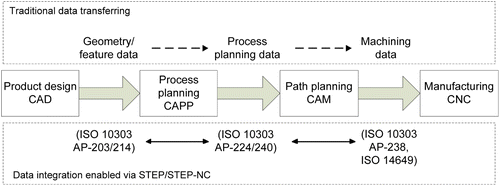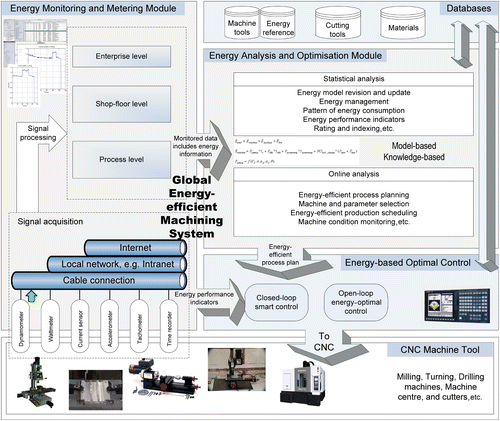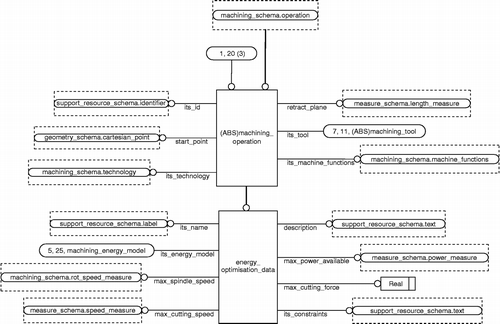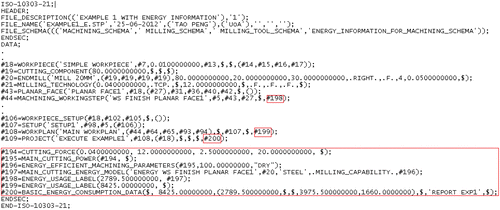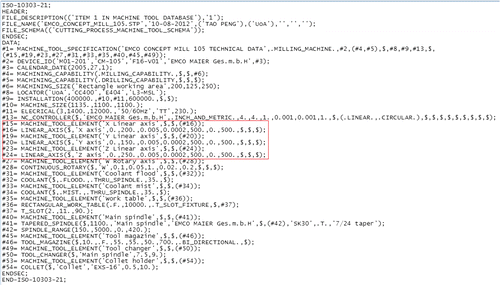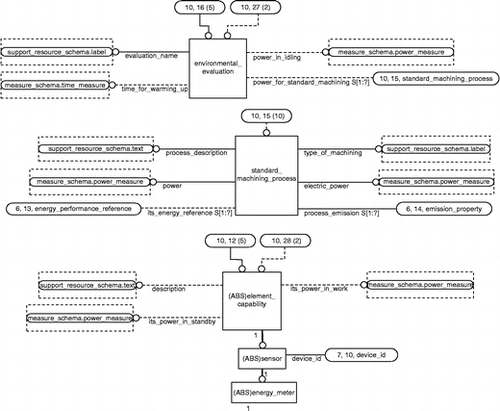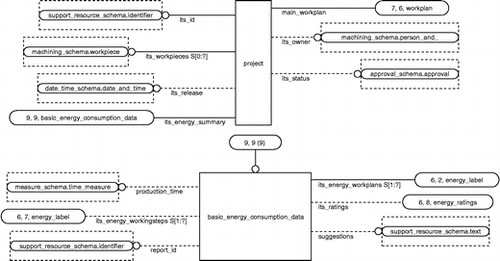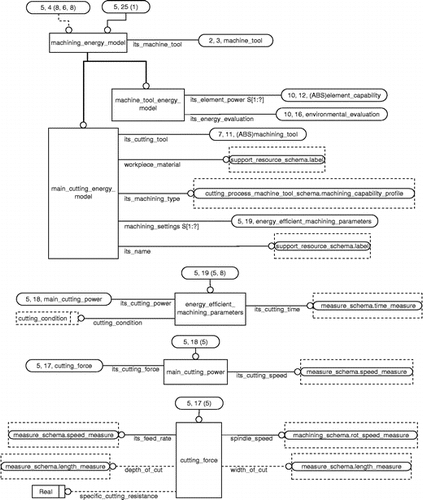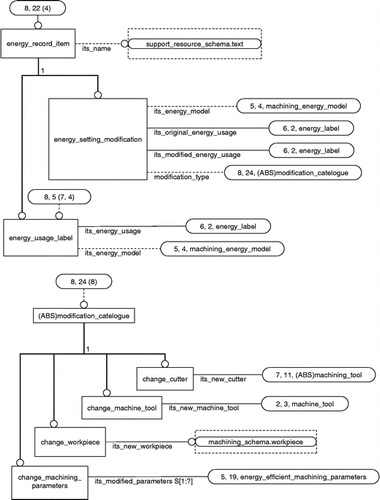Abstract
In the twenty-first century, the continuous demand in energy resource has put sustainability on the agenda of many businesses. This is particularly true for the manufacturing industry, where a large amount of energy is consumed to sustain daily operations. This paper studies energy-efficient computer numerical control machining systems. To achieve overall energy efficiency in machining systems, several activities are involved as in the proposed research framework of a global energy-efficient machining system (GEMS). These activities are described as modules, i.e. energy monitoring, energy analysis and optimisation, energy-based optimal control and energy-enriched database. In a GEMS, one critical issue is data interoperability. Seamless data sharing enables collaboration for improving energy efficiency. Using the EXPRESS language, energy data models are proposed for each module in the GEMS, and integrated with the existing STEP-NC (STandard for Exchange of Produce-compliant Numerical Control) standards. Two case studies are presented to demonstrate how the proposed data models may be used. One study updates an existing production file to include general energy information for auditing or reviewing purposes; the other study maintains machine tool energy profiles in a database. Many other energy-efficient activities, e.g. online energy optimisation, can be realised with the proposed data models. The present study proved that interoperable energy information can enhance the energy-efficient performance of a machining system.
1. Introduction
Nowadays, global competition in the manufacturing industry has become more intense than ever before. Sustainable development is emerging as a key issue to be considered. Machining is a key process in the metalworking industry. Sustainable issues in machining processes include energy-efficient machining, clean machining and lean machining. Energy usage by a computer numerical control (CNC) machine tool (employed in 70% of manufacturing jobs around the world) is a too big share to be ignored (Swamidas and Winch Citation2003). According to the European Union Commission, 70% of power consumption for industrial production was used by electrical drive systems. Machine tools themselves can account for up to 68% of the total energy consumption. Improving energy efficiency therefore becomes a critical step towards enhancing the competitiveness of manufacturing enterprises and developing a green (environmentally benign) image for businesses.
The issue of energy efficiency in CNC machining systems has been studied for some time. Preliminary results have been reported on topics including energy consumption modelling (Draganescu, Gheorghe, and Doicin Citation2003; Neugebauer et al. Citation2010), energy-efficient process planning (Srinivasan and Sheng Citation1999a, Citation1999b; Anderberg, Beno, and Pejryd Citation2011) and energy-based optimal control (Anderberg, Kara, and Beno Citation2010; Verl et al. Citation2011). However, the complexity of a CNC machining system, such as the diverse nature of workpiece materials, the sophisticated machine structure and various machining parameters, makes optimisation a non-trivial task. A comprehensive review on energy-efficient machining systems can be found in CitationPeng and Xu (forthcoming). In that survey, it has been observed that to achieve the overall energy efficiency, enabling technologies along with the computer-aided technologies (CAx) chain need to be tightly integrated. A typical scenario of traditional data transferring in a CAx chain is depicted in Figure . There is a need to share energy information between different activities. The paper is organised as follows. Section 2 reviews the necessity of including energy information and how energy information may be utilised. Section 3 proposes a research framework of a global energy-efficient machining system (GEMS). The section also presents the functionality of its modules. These functional modules include an advanced energy metering and monitoring system, a comprehensive energy data analysis system, a smart energy-based optimal controller and a complete database. It also discusses the issue of the interoperability of energy data. To improve energy efficiency, data exchange between different modules in a GEMS is available. For example, energy-related data from a machining process become available to assist process planning or life-cycle analysis (Heilala et al. Citation2010).
Standardised data representation and exchange proved to be an effective way to achieve interoperability. Therefore, based on the existing standards, we propose an energy data model for CNC machining systems. Section 4 presents two case studies to demonstrate how the proposed data model may be used. Of these two studies, one augments an existing production file with energy information and the other maintains machine tool energy records in a standardised format. Section 5 gives discussion and conclusions, where future work is also envisaged.
2. Interoperable energy-efficient machining
This section reviews the existing research in energy-efficient machining, which suggests a holistic approach that needs to be taken for different aspects of machining processes. The main focus is on global energy efficiency. Here, the issue of data interoperability is discussed, where a standardised energy data model is tipped as a feasible solution.
2.1. Energy-efficient machining
Traditional metalworking operations, e.g. milling, turning and drilling, are the first group of operations considered in this paper. CNC machine tools are widely adopted to perform these operations. Over the years, researchers in this area have endeavoured to understand energy consumption behaviours during machining operations, and have tried to identify the factors that contribute to energy consumption. A brief history of energy modelling approaches is given below, and a complete classification of these methods can be found in Peng and Xu (Citation2012).
Energy consumption modelling began with examining cutter–workpiece interactions (Munoz and Sheng Citation1995). Numerous models were proposed to estimate actual cutting energy (Bayoumi, Yücesan, and Hutton Citation1994; Kishawy, Kannan, and Balazinski Citation2004; Shao, Wang, and Zhao Citation2004; Palanisamy et al. Citation2006). Mathematical models may be powerful (Newman, Nassehi, and Imani-Asra Citation2012), but developing an effective one is often very time consuming. Nonetheless, theoretical analysis offers some insights into some critical factors that affect energy consumption, such as tool properties and workpiece materials (Shao, Wang, and Zhao Citation2004). Later on, with the development of computing technology, statistic modelling [e.g. response surface methodology (Draganescu, Gheorghe, and Doicin Citation2003)] became popular. The so-called empirical models were developed to establish the relationship between main variables and energy usage (Draganescu, Gheorghe, and Doicin Citation2003; Kadirgama and Abou-El-Hossein Citation2005). This approach allows analysts to select the interested or controllable factors and to consider more factors during experimental testing, e.g. machining condition (Aggarwal et al. Citation2008). Although an empirical model gives only an approximation and requires a large amount of testing data, it is often regarded as a practical approach. Research into these two areas mostly concentrates on one part of energy consumption, i.e. actual cutting energy. However, nowadays, researchers dealing with sophisticated CNC machining systems have realised that the actual cutting energy only accounts for 15–25% of the total energy consumed by a CNC machine tool (Dahmus and Gutowski Citation2004; Gutowski et al. Citation2005). The way in which a machine tool operates can help reduce the non-value-added energy usage (Mouzon, Yildirim, and Twomey Citation2007). Discrete event-based modelling was introduced (Dietmair and Verl Citation2009), where more components of a CNC machine tool were taken into consideration. Thus, a more complete and detailed energy profile can be obtained. A similar concept using Therblig-based energy modelling was developed to build the entire energy model on top of a motion element (Jia, Tang, and Lv Citation2013). Nevertheless, systematic models based on physical structure, kinematics and dynamics are extremely challenging due to numerous components and the complex structure of a system. Although Bi and Wang (Citation2012) reported the modelling of the energy of a parallel kinematic machine tool, further research is still urgently required.
Collectively, past research work has attributed energy consumption to three groups of factors, i.e. machining parameters, set-up conditions and machine tool structure (Table ), among which the machine tool structure seems to be most significant. Set-up conditions including lubricant selection, tool rake angle, tool oblique angle and part geometry are found to be more influential than machining parameters. Among the machining parameters, researchers have tended to agree that feed rate and cutting speed are major contributing factors, followed by depth of the cut and width of the cut.
Table 1 Influential factors of energy consumption in machining processes.
Currently, energy data is not typically regarded as an integral part of process planning or optimisation (Gupta Citation2005). Studies on energy optimisation are conducted mainly in the domains of energy-efficient process planning and production scheduling. Most solutions aim to address a specific issue in production, which is not applicable to others; energy models used also tend to be incomplete. Moreover, to create adequate awareness of energy information, advanced energy monitoring is necessary (Zein et al. Citation2011). Such a system can bridge the gap between an enterprise information system and a production system (Cannata, Karnouskos, and Taisch Citation2009), enabling online energy optimisation for machining processes. There is also a need for storing the collected energy information to be captured in a database. A well-organised database should contain energy profiles of machine tools, as the representative data from previous operations help consolidate expertise knowledge of energy-efficient practice. The development of energy-efficient optimal control is another important task. Existing efforts focus on providing appropriate machine tool models (Schlechtendahl, Eberspächer, and Verl Citation2012; Peng and Xu Citation2013) and energy information to controllers (Peng, Xu, and Heilala Citation2012; Schlechtendahl et al. Citation2012). Energy-efficient control strategies that consider energy as one objective to optimise rather than as a constraint to meet are still in demand. All of the above-mentioned aspects are to be considered for the achievement of global energy efficiency.
2.2. Interoperability of energy data
Figure shows the IDEF0 diagram illustrating how energy data flows between energy-efficient machining processes. The various activities depicted in this figure are seamlessly connected in order to share energy knowledge and energy data in a systematic manner. To enable data interoperability, a standardised data format is naturally considered. As one of such formats, STEP (STandard for Exchange of Produce), registered as ISO 10303 (ISO Citation1994), has been developed to enhance the interoperability of product data. It is a family of standards defining methodology for describing product data throughout the life cycle of a product in a neutral mechanism. Data models formally define data objects and relationships among data objects for a certain domain, and are specified in a data modelling language, i.e. EXPRESS [EXPRESS is defined in Part 11 of STEP (ISO Citation1994)]. STEP provides fast, reliable data exchange between partners and suppliers using different systems. Extensive STEP capabilities have been developed for multiple industries, e.g. automotive industry (ISO Citation1994). STEP-compliant Numerical Control, known as STEP-NC, has been developed particularly for the machining industry. STEP-NC is task-oriented and fully compliant with the STEP standard. Using STEP, data integration becomes achievable in the CAx chain (ISO Citation2001) (Figure ). Global efforts have been made in developing and testing STEP-NC by research groups from countries such as Germany, Switzerland, the UK, Korea, the USA and New Zealand (Xu et al. Citation2005). Of all the published STEP-NC parts (Part 1 [ISO Citation2003], 10 [ISO Citation2004], 11 [ISO Citation2004], 12 [ISO Citation2005], 111 [ISO Citation2003], 121 [ISO Citation2003] and 201 [ISO Citation2011]), very little energy information is included. There is a need to develop a compatible energy data model and integrate it with the existing STEP-NC data model. In this study, data models are proposed to store energy information for CNC machining and integrate it with STEP-NC. Energy data models are developed using the EXPRESS language and documented in the ENERGY_INFORMATION_FOR_MACHINING schema.
Other relevant standards are being developed in parallel. One such standard is ISO 14955, which tries to establish a method to evaluate the environmental impact of machine tools, including eco-design and testing on metal cutting machines (ISO/DIS Citation2012). ISO 20140 aims to standardise the evaluation procedure and the data model for environmental performance of manufacturing systems (ISO/DIS Citation2012). Both standards are still at the drafting stage. The data models proposed in this study is complementary to ISO 14955/20140.
3. System framework and data model
To combat the problems mentioned above, the framework of a GEMS is proposed (Figure ). The GEMS was initially developed for conventional machining processes, e.g. milling, turning and drilling, but the concept can easily be applied to other traditional machining processes, e.g. shaping and reaming, with minor adjustments. There are four modules in the framework, i.e. energy monitoring and metering, energy analysis and optimisation, energy-based optimal control and databases.
3.1. Energy monitoring and metering module
Kara, Bogdanski, and Li (Citation2011) summarised energy monitoring and metering methods in manufacturing systems. Zein et al. (Citation2011) listed energy-efficient measures for the design and operation of machine tools. They also discussed how to select and prioritise energy-efficient measures to create adequate awareness. In this module, energy-related signals are captured by a set of sensors, e.g. dynamometer, wattmeter and accelerometer, and the duration of different states is timed by the controller. These data are appropriately conditioned and formatted when transferred via an available network. Various studies have identified the vast potential of adopting standards to support energy-efficient monitoring (Lee et al. Citation2010; Mani et al. Citation2010). MTConnect (Citation2008) that is designed to foster greater interoperability between shop floor and monitoring applications is one of such emerging standards. All the signals are processed and hierarchically organised into three groups, namely direct, indirect and non-value-added energy consumption. For instance, cutting power is regarded as direct energy consumption, while vibration monitored is considered as non-value-added energy consumption to be reduced or eliminated in addition to safety and quality concerns. In this sense, data can be easily accessed and manipulated for different purposes. The outcomes of this module are ready to be used by different applications.
The first part of the energy data model is proposed to support monitoring. Inspired by the traceability data model developed by Campos and Miguez (Citation2011), new data models are introduced and connected to ENTITY nc_function in ISO 14649-10 to enable automated energy monitoring. A holistic view of this group is illustrated in Figure .
The entities fall into three subgroups (SG). SG-I is designed to hold the information from the current system for future use. SG-II aims to support automated energy monitoring and can be inserted into a CNC program to provide the data for appropriate data acquisition. Finally, SG-III holds the data for formatting and generating the energy report for reviewing or auditing purposes. Table describes the proposed entities in more detail.
Table 2 Automated energy monitoring and recording functions.
3.2. Energy analysis and optimisation module
Energy-related machining data has been utilised in different applications, e.g. tool condition monitoring (Byrne et al. Citation1995; Rehorn, Jiang, and Orban Citation2005) and quality control (Ramesh, Mannan, and Poo Citation2000a, Citation2000b). In the GEMS, utilisation of energy-related machining data is the main task of this module. Using the monitored energy data, both online and statistical analyses can be performed. In the online analysis, data is analysed in the loop to support real-time machine control. Its functionality covers energy-efficient process planning, machining parameter optimisation and production scheduling, though it can be further extended. The energy consumption models briefly reviewed in Section 2.1 can be utilised to enhance model-based optimisation. As one of the outputs, the energy-efficient process plan is generated to facilitate decision-making in a control system. On the other hand, the statistical analysis is based on extensive and historical data processing, e.g. pattern of energy consumption and energy model revision and update. Statistical results can also provide valuable information on applications, such as computer-aided design and enterprise resource planning. The actual machine tool capability or power constraints are considered.
One essential part of the data model is the energy consumption data model, which is regarded as the key to energy-efficient machining (Peng and Xu Citation2012). The influential factors summarised in Table are carefully considered. The abstract ENTITY machining_energy_model is proposed as a supertype of ENTITY machine_tool_energy_model and main_cutting_energy_model. To support major applications, the former data model focuses on the overall energy profile of a machine tool system, while the latter is more interested in the cutting energy component (Figure ). The details of the data model can be found in Appendix A.
To describe the energy usage of a machine tool, data models are connected tightly with ISO 14649 Part 201 (ISO Citation2011). Two new entities, i.e. its_power_in_work and its_power_in_standby, are added to ENTITY element_capability to give the ability to represent power performance. ENTITY environmental_evaluation is also extended to have power_for_standard_machining as a new attribute.
Another part of the data model is designed to hold the estimated energy usage after the analysis. The process is called energy labelling. The main purpose of energy labelling is to give an indicative energy consumption level. This can be done in two ways: energy label for a selected workplan or workingstep or as a result of optimisation for the project (see Appendix A for complete data models). Actual alternations are not recorded here, but given in an energy report (see Section 3.1).
3.3. Energy-based optimal control module
ENTITY energy_optimisation_data is proposed to contain the information for online optimisation executed by the intelligent CNC controller (Figure ). Inclusion of energy_optimisation_data in a CNC program provides the controller with the data to adapt the settings autonomously for the subsequent steps based on a specified energy model. It enhances smart controller performance in an energy-efficient fashion.
To cater for a wide range of machine tools (e.g. manual and semi-automatic ones), both open- and closed-loop control systems are supported in this module. In an open-loop system, the controller (or human operator) follows the energy-efficient process plan generated by the energy analysis module to execute the machining process. It is similar to the existing procedure, so it requires less effort on machine tool modification in terms of time and cost. However, it requires a good knowledge of the machining process and leaves little flexibility and adaptivity to the operators at the shop floor. On the other hand, in a closed-loop system, feedback from the machining process at the shop floor is considered. The energy indicators suggested by the energy analysis module enable an adaptive control of the machine tool. However, sometimes major modifications or even a redesign of the machine tool controller is required.
3.4. Databases
Clearly, there are abundant data related to machining processes. For this reason, several databases are constructed in the GEMS, e.g. databases for machine tools, cutting tools, materials and energy profile. Databases provide the necessary information for energy analysis and optimal control. The energy profile database stores the expertise data collected that can be used to evaluate future performance. This database is integrated with the machine tool database. This is because energy performance is often machine tool dependent; the structure, capability and condition of a machine tool all affect the total energy usage. The same part machined on different machine tools yields different energy usage patterns. Therefore, ENTITY energy_performance_reference is proposed to store historical energy data of a machine tool (Figure ).
ENTITY Machining_energy_model is used to maintain an energy performance record. How to quantify energy-efficient performance in a simple and standard way (e.g. the energy ratings) is outside the scope of this paper.
In summary, the GEMS defines the scope of an energy-efficient machining system. It can serve as a guideline to develop a concrete energy-efficient machining system tailored to the needs of an enterprise. The energy data model, proposed in this paper, enhances energy-efficient CNC machining. It is fully harmonised with other parts of the STEP-NC standards (Figure ). All EXPRESS-G diagrams of the developed data models are developed using ST-Developer™ version 14 (Citation2010).
4. Case studies
Two case studies are presented to demonstrate the possible use of the proposed data models. The first one enriches a production file with energy usage estimation to give a basic idea of how much energy is expected to be consumed during production. Energy estimation can be obtained by employing a suitable energy model or based on available knowledge, e.g. previous operations or nominal power. The actual energy usage usually differs from what has been estimated. This is often due to changed machining settings or simplification and approximation at the modelling stage. Therefore, this information can be updated after machining is completed, if the monitored data is captured. Two sets of data can then be compared to assist in the revision of the energy model. The second case study shows how the energy performance of a machine tool is stored in a database. Because energy consumption data are machine and operation specific, this database serves essentially as the data centre. In future, the data can be treated as a reference for the use of the same machine tool or machine health diagnosis. Moreover, standardising the representation and sharing of such data can provide useful consultation to other systems such as production planning.
4.1. Case 1 – augmentation of energy information
This study demonstrates how the proposed energy data model may be used. The sample piece is Example 1 in ISO 14649 Part 11 (2004) (Figure ). To produce this part, five working steps are required, i.e. planar face finishing, hole drilling, hole reaming, pocket roughing and pocket finishing. The original STEP-NC file contains no energy information.
The calculated basic energy usage of the project is appended at the end of the file. The energy data shows how much energy is expected to be consumed that can be updated after machining is completed. As an example, the preliminary calculation is based on the first-order power model, as expressed in Equation (1), for milling stainless steel with a carbide-coated cutting tool (Kadirgama and Abou-El-Hossein Citation2005). The production time is set to be 100 s:
4.2. Case 2 – machine tool energy reference
The newly published ISO 14649-201 enables machine tool modelling in a standardised format. The energy data model extended in this part can also be used to record energy performance. First, a Part 21 file of machine tool specification data is developed for EMCO Concept Mill 105 in the Manufacturing System Laboratory of University of Auckland. The main technical data of the milling machine are included in the machine tool specification. Figure illustrates the coded Part 21 file, with the machine tool data of positioning range of X, Y and Z axes indicated by a box.
Then, the proposed schema is added. In this case, the cutting energy is recorded and saved as the energy profile, including the information such as cutting tool. Figure shows the updated Part 21 file. A reference of energy usage (boxed) is calculated using the same energy model as in case study 1. The previous energy performance data of machining can be maintained in the database. The same piece of information can also be accessed by other applications that are proposed for energy-efficient performance.
5. Discussion and conclusions
The drive for increased competitiveness, reduced energy consumption, better integration and reduced overall cost pushes for energy-efficient machining. It has become evident that machine tool vendors and users have desire to improve energy efficiency of both the machine tool itself and operation strategies. To achieve energy savings in the entire machining process, multiple activities are involved. Therefore, making energy data interoperable across different activities is a key factor. This research is a necessary and crucial step towards including energy information in a shared database.
The framework of the GEMS outlines the elements to develop an energy-efficient machining system. The aim is to improve global energy efficiency. The four modules of the GEMS cover four different areas, i.e. energy monitoring, energy analysis and optimisation, energy-based optimal control and sustaining databases. The GEMS supports fully aware energy monitoring, intelligent analysis, effective optimisation and smart machine control systems. In particular, the issue of energy data sharing between different systems is addressed. Energy data models for CNC machining systems are developed in the EXPRESS language and well connected to the STEP-NC standards. It augments the existing STEP-NC data model with energy information and supports energy-efficient machining processes. The proposed data models are stipulated in the ENERGY_INFORMATION_FOR_MACHINING schema. It supports automated energy monitoring, recording, labelling and optimising processes. To formally integrate the proposed energy data model into the STEP-NC standards, discussions and dialogues with peer researchers are being conducted.
The proposed data model can support the development of the next-generation intelligent CNC machine tools. For example, automated energy monitoring can be enabled by having a standardised energy monitoring data structure in a part program. As the part program is executed, the smart CNC controller can automatically activate the relevant sensor to capture the data and organise it in a consistent manner. The system can choose the most appropriate signal for recording if there is more than one sensor available. The recorded energy profile can be stored in a separate file for post-machining analysis. One can re-evaluate the energy consumption planned at the beginning and update the energy profile.
Other benefits that the GEMS aims to offer include but not limited to:
Design for manufacturing. Using energy consumption models, the amount of energy consumption can be predicted and considered at the design stage.
Energy-efficient process and production planning. Different machining sequences and settings lead to different energy usage patterns. The proposed system can cope with last-minute changes at the shop floor in an effect to achieve an energy-efficient process.
Resource management. At the higher level, the system allows for consideration of distributed resources available within an organisation. The entire manufacturing capability can be achieved and workload balanced.
Enterprise investment guidance. The energy profiles of all the machine tools (embodied in the database) present an overview of the entire machining capabilities and energy usage implications, so that key issues or bottlenecks can be identified for future investment.
The next development phase of the GEMS is energy consumption optimisation for machining operations, and energy-based optimal control of CNC machines based on STEP-NC. An effective and accurate energy model is needed to perform optimisation. Depending on the properties of the energy model, suitable optimisation methods can be selected such as mathematical programming or intelligent computing, including evolutionary algorithms and artificial neural networks. Multiple objectives are always intended as energy efficiency that needs to be balanced with time and cost without sacrificing product quality. The constraints on the available measurement devices or controllable factors should be considered carefully. Development of a software tool to assist in energy data monitoring and analysis is another future task. Utilising existing communication protocols for machining systems, e.g. MTConnect, is an option.
Acknowledgements
The authors acknowledge the financial support provided by the China Scholarship Council and the University of Auckland Joint Scholarship, and the researchers of the Interoperable and Intelligent Manufacturing System (IIMS) group, the University of Auckland, for their valuable comments.
Notes
1. Email: [email protected]
REFERENCES
- Aggarwal, A., H.Singh, P.Kumar, and M.Singh. 2008. “Optimizing Power Consumption for CNC Turned Parts Using Response Surface Methodology and Taguchi's Technique – A Comparative Analysis.” Journal of Materials Processing Technology200 (1–3): 373–384. 10.1016/j.jmatprotec.2007.09.041.
- Anderberg, S., T.Beno, and L.Pejryd. 2011. “Energy and Cost Efficiency in CNC Machining from a Process Planning Perspective.” In Proceedings of the 9th Global Conference on Sustainable Manufacturing, St Petersburg, Russia, 383–389.
- Anderberg, S., S.Kara, and T.Beno. 2010. “Impact of Energy Efficiency on Computer Numerically Controlled Machining.” Proceedings of the Institution of Mechanical Engineers, Part B: Journal of Engineering Manufacture224 (4): 531–541. 10.1243/09544054JEM1712..
- Bayoumi, A. E., G.Yücesan, and D. V.Hutton. 1994. “On the Closed form Mechanistic Modeling of Milling: Specific Cutting Energy, Torque, and Power.” Journal of Materials Engineering and Performance3 (1): 151–158. 10.1007/BF02654511.
- Bi, Z. M., and L.Wang. 2012. “Optimization of Machining Processes from the Perspective of Energy Consumption: A Case Study.” Journal of Manufacturing Systems31: 420–428. 10.1016/j.jmsy.2012.07.002.
- Byrne, G., D.Dornfeld, I.Inasaki, G.Ketteler, W.König, and R.Teti. 1995. “Tool Condition Monitoring (TCM) – The Status of Research and Industrial Application.” CIRP Annals – Manufacturing Technology44 (2): 541–567. 10.1016/S0007-8506(07)60503-4.
- Campos, J. G., and L. R.Miguez. 2011. “Standard Process Monitoring and Traceability Programming in Collaborative CAD/CAM/CNC Manufacturing Scenarios.” Computers in Industry62: 311–322.
- Cannata, A., S.Karnouskos, and M.Taisch. 2009. “Energy Efficiency Driven Process Analysis and Optimization in Discrete Manufacturing.” In Proceedings of the Industrial Electronics Conference, Porto, Portugal, 4449–4454.
- Dahmus, J. B., and T. G.Gutowski. 2004. “An Environmental Analysis of Machining.” In Proceedings of the International Mechanical Engineering Congress and RD&D Expo, Anaheim, CA, USA, 1–10.
- Dietmair, A., and A.Verl. 2009. “A Generic Energy Consumption Model for Decision Making and Energy Efficiency Optimisation in Manufacturing.” International Journal of Sustainable Engineering2 (2): 123–133.
- Draganescu, F., M.Gheorghe, and C. V.Doicin. 2003. “Models of Machine Tool Efficiency and Specific Consumed Energy.” Journal of Materials Processing Technology141 (1): 9–15.
- Gupta, D. P.2005. “Energy Sensitive Machining Parameter Optimization Model.” Master thesis, West Virginia University.
- Gutowski, T., C.Murphy, D.Allen, D.Bauer, B.Bras, T.Piwonka, P.Sheng, J.Sutherland, D.Thurston, and E.Wolff. 2005. “Environmentally Benign Manufacturing: Observations from Japan, Europe and the United States.” Journal of Cleaner Production13 (1): 1–17.
- Heilala, J., K.Klobut, T.Salonen, P.Järvinen, P.Siltanen, and J.Shemeikka. 2010. “Energy Efficient Enhancement in Discrete Manufacturing with Energy Use Parameters.” In Competitive and Sustainable Manufacturing Products and Service: Proceedings of the International Conference on Advances in Production Management Systems, Cernobbio-Como, Italy, 226–233.
- ISO (International Organisation for Standardisation). 1994. 10303-1, Industrial Automation Systems and Integration – Product Data Representation and Exchange – Part 1: Overview and Fundamental Principles. Geneva, Switzerland: International Organisation for Standardisation.
- ISO (International Organisation for Standardisation). 1994. 10303-11, Industrial Automation Systems and Integration – Product Data Representation and Exchange – Part 11: Description Methods: The EXPRESS Language Reference Manual. Geneva, Switzerland: International Organisation for Standardisation.
- ISO (International Organisation for Standardisation). 1994. 10303-214, Industrial Automation Systems and Integration – Product Data Representation and Exchange – Part 214: Application Protocol: Core Data for Automotive Mechanical Design Processes. Geneva, Switzerland: International Organisation for Standardisation.
- ISO (International Organisation for Standardisation). 2001. 10303-224, Industrial Automation Systems and Integration – Product Data Representation and Exchange – Part 224: Application Protocol: Mechanical Product Definition for Process Plans Using Machining Features. Geneva, Switzerland: International Organisation for Standardisation.
- ISO (International Organisation for Standardisation). 2003. 14649-1, Data Model for Computerized Numerical Controllers: Part 1 Overview and Fundamental Principles. Geneva, Switzerland: International Organisation for Standardisation.
- ISO (International Organisation for Standardisation). 2003. 14649-111, Data Model for Computerized Numerical Controllers: Part 111 Tools for Milling. Geneva, Switzerland: International Organisation for Standardisation.
- ISO (International Organisation for Standardisation). 2003. 14649-121, Data Model for Computerized Numerical Controller: Part 121 Tools for Turning. Geneva, Switzerland: International Organisation for Standardisation.
- ISO (International Organisation for Standardisation). 2004. 14649-10, Data Model for Computerized Numerical Controllers: Part 10 General Process Data. Geneva, Switzerland: International Organisation for Standardisation.
- ISO (International Organisation for Standardisation). 2004. 14649-11, Data Model for Computerized Numerical Controllers: Part 11 Process Data for Milling. Geneva, Switzerland: International Organisation for Standardisation.
- ISO (International Organisation for Standardisation). 2005. 14649-12, Data Model for Computerized Numerical Controller: Part 12 Process Data for Turning. Geneva, Switzerland: International Organisation for Standardisation.
- ISO (International Organisation for Standardisation). 2011. 14649-201, Data Model for Computerized Numerical Controllers: Part 201 Machine Tool Data for Cutting Process. Geneva, Switzerland: International Organisation for Standardisation.
- ISO/DIS. 2012. 14955-1, Machine Tools – Environmental Evaluation of Machine Tools – Part 1: Design Methodology for Energy-Efficient Machine Tools. Geneva, Switzerland: International Organisation for Standardisation.
- ISO/DIS. 2012. 20140-1, Automation Systems and Integration – Evaluating Energy Efficiency and Other Factors of Manufacturing Systems that Influence the Environment – Part 1: Overview and General Principles. Geneva, Switzerland: International Organisation for Standardisation.
- Jia, S., R.Tang, and J.Lv. 2013. “Therblig-based Energy Demand Modeling Methodology of Machining Process to Support Intelligent Manufacturing.” Journal of Intelligent Manufacturing1–19. 10.1007/s10845-012-0723-9.
- Kadirgama, K., and K.Abou-El-Hossein. 2005. “Power Prediction Model for Milling 618 Stainless Steel Using Response Surface Methodology.” American Journal of Applied Sciences2 (7): 1182–1187.
- Kara, S., G.Bogdanski, and W.Li. 2011. “Electricity Metering and Monitoring in Manufacturing Systems.” In Glocalized Solutions for Sustainability in Manufacturing – Proceedings of the 18th CIRP International Conference on Life Cycle Engineering, Braunschweig, Germany, 1–10.
- Kishawy, H. A., S.Kannan, and M.Balazinski. 2004. “An Energy Based Analytical Force Model for Orthogonal Cutting of Metal Matrix Composites.” CIRP Annals – Manufacturing Technology53 (1): 91–94.
- Lee, B. E., J.Michaloski, F.Proctor, S.Venkatesh, and N.Bengtsson. 2010. “MT-Connect-Based Kaizen for Machine Tool Processes.” In Proceedings of ASME 2010 International Design Engineering Technical Conference & Computers and Information in Engineering Conference, Montreal, Quebec, Canada, 1–8.
- Mani, M. L. M., S.Leong, K.Lyons, A.Ranta, K.Lkkala, and N.Bengtsson. 2010. “Impact of Energy Measurements in Machining Operations.” In Proceedings of the ASME 2010 International Design Engineering Technical Conference & Computers and Information in Engineering Conference, Montreal, Quebec, Canada, 867–873.
- Mouzon, G., M. B.Yildirim, and J.Twomey. 2007. “Operational Methods for Minimization of Energy Consumption of Manufacturing Equipment.” International Journal of Production Research45 (18–19): 4247–4271.
- MTConnect. 2008. “What is MTConnect?” Accessed August 12, 2012. http://mtconnect.org/.
- Munoz, A. A., and P.Sheng. 1995. “An Analytical Approach for Determining the Environmental Impact of Machining Processes.” Journal of Materials Processing Technology53 (3–4): 736–758.
- Neugebauer, R., R. Wertheim, C. Hochmuth, G. Schmidt, and M. Dix. 2010. “Modelling of Energy and Resource-Efficient Machining.” Paper presented at the 4th CIRP International Conference on High Performance Cutting, Gifu, Japan.
- Newman, S. T., A.Nassehi, and R.Iman-Asrai. 2012. “Energy Efficient Process Planning for CNC Machining.” CIRP Journal of Manufacturing Science and Technology5 (2): 127–136.
- Palanisamy, P., I.Rajendran, S.Shanmugasundaram, and R.Saravanan. 2006. “Prediction of Cutting Force and Temperature Rise in the End-Milling Operation.” Proceedings of the Institution of Mechanical Engineers, Part B: Journal of Engineering Manufacture220 (10): 1577–1587.
- Peng, T., and X.Xu. forthcoming. “Energy-Efficient Machining Systems: A Critical Review.” The International Journal of Advanced Manufacturing Technology. To appear.
- Peng, T., and X.Xu. 2012. “The State of the Art in Energy Consumption Model – The Key to Sustainable Machining.” Applied Mechanics and Materials232: 592–599.
- Peng, T., and X.Xu. 2013. “A Universal Hybrid Energy Consumption Model for CNC Machining Systems.” In Proceedings of the 20th CIRP International Conference on Life Cycle Engineering, Singapore, 251–256.
- Peng, T., X.Xu, and J.Heilala. 2012. “Energy-Efficient Machining via Energy Data Integration.” In Competitive Manufacturing for Innovative Products and Services: Proceedings of the APMS 2012 Conference, Advances in Production Management Systems, Rhodes island, Greece, 1–8.
- Ramesh, R., M. A.Mannan, and A. N.Poo. 2000a. “Error Compensation in Machine Tools – A Review: Part I: Geometric, Cutting-Force Induced and Fixture-Dependent Errors.” International Journal of Machine Tools and Manufacture40 (9): 1235–1256.
- Ramesh, R., M. A.Mannan, and A. N.Poo. 2000b. “Error Compensation in Machine Tools – A Review: Part II: Thermal Errors.” International Journal of Machine Tools and Manufacture40 (9): 1257–1284.
- Rehorn, A. G., J.Jiang, and P. E.Orban. 2005. “State-of-the-Art Methods and Results in Tool Condition Monitoring: A Review.” International Journal of Advanced Manufacturing Technology26 (7–8): 693–710.
- Schlechtendahl, J., P.Eberspächer, and A.Verl. 2012. “Model Based Consumption Monitoring and Control.” In Proceedings of the 22nd International Conference on Flexible Automation and Intelligent Manufacturing, Helsinki, Finland, 829–836.
- Schlechtendahl, J., P.Sommer, P.Eberspächer, and A.Verl. 2012. “Automated Linkage of Consumption Models and Control Information in Control Systems.” In Proceedings of the 19th CIRP International Conference on Life Cycle Engineering, Berkeley, USA, 387–391.
- Shao, H., H. L.Wang, and X. M.Zhao. 2004. “A Cutting Power Model for Tool Wear Monitoring in Milling.” International Journal of Machine Tools and Manufacture44 (14): 1503–1509.
- Srinivasan, M., and P.Sheng. 1999a. “Feature-Based Process Planning for Environmentally Conscious Machining – Part 1: Microplanning.” Robotics and Computer-Integrated Manufacturing15 (3): 257–270.
- Srinivasan, M., and P.Sheng. 1999b. “Feature-Based Process Planning in Environmentally Conscious Machining – Part 2: Macroplanning.” Robotics and Computer-Integrated Manufacturing15 (3): 271–281.
- STEP Tools, Inc.2010. ST-Developer Version 14.0. Troy, NY: STEP Tools, Inc.
- Swamidas, P. M., and G. W.Winch. 2003. “Exploratory Study of Adoption of Manufacturing Technology Innovations in the USA and the UK.” International Journal of Production Research40 (12): 2677–2700.
- Verl, A., E.Abele, U.Heisel, A.Dietmair, P.Eberspächer, R.Rahäuser, S.Schrems, and S.Braun. 2011. “Modular Modeling of Energy Consumption for Monitoring and Control.” In Glocalized Solutions for Sustainability in Manufacturing – Proceedings of the 18th CIRP International Conference on Life Cycle Engineering, Braunschweig, Germany, 341–346.
- Xu, X., H.Wang, J.Mao, S.Newman, T.Kramer, F.Proctor, and J.Michaloski. 2005. “STEP-Compliant NC Research: The Search for Intelligent CAD/CAPP/CAM/CNC Integration.” International Journal of Production Research43 (17): 3703–3743.
- Zein, A., W.Li, C.Herrmann, and S.Kara. 2011. “Energy Efficiency Measures for the Design and Operation of Machine Tools: An Axiomatic Approach.” In Glocalized Solutions for Sustainability in Manufacturing – Proceedings of the 18th CIRP International Conference on Life Cycle Engineering, Braunschweig, Germany, 274–279.

